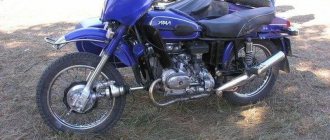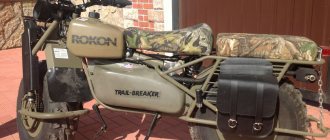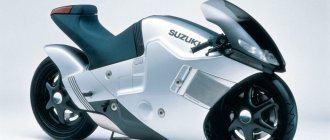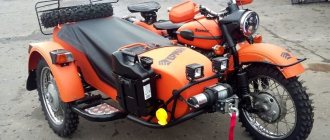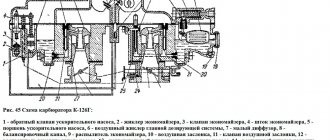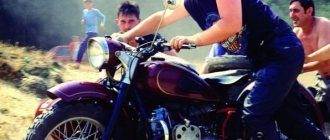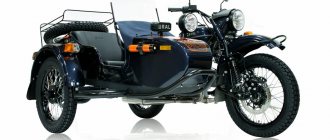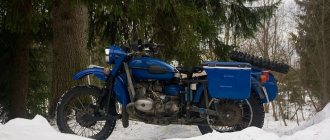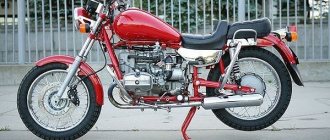All-wheel drive motorcycles are nothing new or unusual. They were created quite a long time ago, and similar vehicles were used mainly to participate in rally-type motorcycle racing. First of all, this is due to the fact that such models cope much better with turns at high speed.
However, unlike four-wheel drive vehicles, a four-wheel drive motorcycle does not have a full-fledged driven front wheel. On the most common models of this type from the Yamaha and KTM brands, only 20% of the power is transmitted to the front wheel. Christini's company was able to create a bike with 50 percent of the power transferred to the front wheel, but this greatly increased the weight of the vehicle. What can domestic models oppose to all this? We will talk now about all the advantages and disadvantages of the Ural all-wheel drive motorcycle .
A little history
Those who like to have a blast on a two-wheeled “iron horse” know for sure that for active recreation, country trips and overcoming dense off-road conditions, there is nothing better than all-wheel drive motorcycles. Among them is the Ural motorcycle, equipped with all-wheel drive.
Few people know that the first all-wheel drive motorcycle appeared almost 100 years ago in the UK. It existed in its class for quite a long time, without serious competitors.
A good ten years later, at the beginning of 1931, BMW began producing not only civilian bikes, but also began producing heavy all-wheel drive motorcycles for military purposes. Many people believe that all-wheel drive appeared due to the needs of the army, where in the distant times of World War II they were extremely necessary. An equally popular brand of motorcycles of that time was the famous Zundapp.
The prototype of the heavy Soviet Ural motorcycles was the above-mentioned units, in particular the R71 model. And so, in 1941, the first heavy motorcycle M72 rolled off the assembly line of the Irbit motorcycle plant, which immediately became part of the equipment for service with the Soviet army.
A classic that never gets old
Literally everything speaks in favor of this comparison: the reliable boxer 40-horsepower engine, the rough powder-coated frame and cradle, and even the sound of the engine running, characteristic of the Urals. At the same time, standard Brembo disc brakes and high-quality Sach suspension components indicate that IMZ does not live solely on the legacy of the Soviet past, but is trying to make Ural as modern and competitive as possible. Excellent colorful additions, which also have enormous practical benefits, were camouflage awnings for the stroller, protecting luggage from dampness and dirt, and gasoline cans, which were very useful when the desire to drive forward was tripped up by the lack of gas stations in the area. The distinctive appearance of Ural motorcycles invariably met with a storm of positive emotions from passers-by during stops, as well as a good-natured desire to talk with their owners.
What happened next
The year 1957 became famous for the fact that the first small batch of all-wheel drive Urals, which were three-wheeled models, was produced. And the M61 became such a motorcycle, completely adopting the chassis design from the 72nd model. It began to be equipped with an overhead valve engine.
A little later, the plant mastered and added an important innovation in the form of reverse gear, which was completely absent on motorcycles with lower valve engines. An example of this is the earlier model - K650.
Gradually, the all-wheel drive Ural motorcycle underwent design changes. In addition to modifications to the engine and the introduction of reverse gear, a fundamentally new carburetor was installed, as a result of which the engine power increased. Subsequently, modern models began to be equipped with high-quality Japanese-made carburetors (“Keihin”). The Ural motorcycle received improved dynamic characteristics and high braking quality thanks to the installed disc brakes, which are considered one of the best in the world.
Advantages and disadvantages of the vehicle
Among the main reasons why the Ural with a leading sidecar is very popular are:
- excellent cross-country ability (the probability of getting stuck anywhere is almost zero);
- good load capacity;
- improved management;
- smoother and softer dynamics.
But the Ural all-wheel drive motorcycle also has some disadvantages. First of all, there is a more complex chassis design. In addition, there is no way to detach the stroller. At the same time, there are clearly more advantages. Especially for those who love driving on difficult roads.
Characteristic features of all-wheel drive units
The Ural motorcycle (see photo above) can safely be called the only motorcycle with a sidecar in the world, which is produced with a non-differential switchable drive. One of the models of Irbit manufacturers was the Patrol motorcycle, which has a switchable sidecar wheel drive. The patrol with a lightweight T-version enjoys considerable success far beyond the borders of Russia. Thus, according to sales results in 2012 alone, 37% more cars were sold than in 2011.
“Patrol” can cope with any off-road conditions, as it is equipped with a 4-speed gearbox. All-wheel drive Ural motorcycles overcome the most difficult sections of roads. So we can say with confidence that this is the best road bike. And indeed, being loaded, it will never let the driver down, under any circumstances. That is why Americans, always skeptical, have great respect for the Ural Patrol. The cost of the Patrol-T model fluctuates around 300 thousand rubles.
When did the first all-wheel drive moped appear?
The model was first demonstrated in 1924 in Britain. For many years this was the only copy. Only almost 3 decades later the famous Rokon bike was made. Its operating principle was based on transmitting torque to the front wheel using two chains.
Despite the fact that there was no suspension, the motorcycle felt great on difficult sections of the road. The weight of such a vehicle did not even reach 100 kg. This motorbike is widely popular in our time .
Video review of the Ural motorcycle with a sidecar drive:
Comfort and relaxation with “Tourist”
The “Tourist-2WD” model (Ural motorcycle) was created especially for Russian roads, which have not seen a replacement for ages. The all-wheel drive of this monster allows you to overcome not only domestic off-road conditions without any problems, but also accelerate along the highway to a speed of 120 km/h, while spending only 7 liters of gasoline for every hundred kilometers.
It’s easy to guess that the Ural motorcycle of the Tourist line is designed for long trips, and for this it is equipped with everything necessary. If desired, the drive of the stroller is turned off and it is disconnected. In this case, you can travel only on two wheels, but this will not make your impression of the unit any worse.
Four-wheel drive motorcycles of the Tourist series are equipped with 45-horsepower engines with a displacement of 750 cm³. At the same time, the cars accelerate to 120 km/h in a matter of seconds ─ as fast as Yamaha sports motorcycles, the prices of which can exceed half a million rubles. Please note that this is with a motorcycle weight of 335 kg, and you can take almost the same amount of equipment and cargo with you in weight, fortunately it has enough “horses” to easily pull such luggage. The fuel tank is designed for 19 liters of fuel, and the consumption is generally ridiculous: in highway conditions - up to 4 liters, and in the urban cycle does not exceed 7 liters for every 100 km.
Ural overseas
Desperate foreign bikers who don’t want to give up an extra few months of their motorcycle season to winter know that there is one brand that frankly doesn’t care about bad weather, because it was created in such conditions and for such conditions. Constant test drives and comparisons make our bikes one of the main “survivors” in their price and weight segment, for which a special patriotic thank you to them.
Currently, the number of motorcycles assembled per year rarely exceeds a thousand, but there is a constant demand for Urals, mainly in Europe and America, where there are about 120 official dealers class=”aligncenter” width=”700″ height=”538″ [/img] One of these dealers, for example, recently provided journalists with several Ural motorcycles with a side trailer, locally called Gear-Up, for a test drive, as well as an experienced travel rider Mr. Cob (short for Cranky Old Bastard).
From the very first minutes, riders had to experience all the features of driving a motorcycle with a cradle, which is unlike anything else on two wheels in the world. At the same time, the Ural itself is not a unit for the fairer sex or sport bikers expecting high torque. The most accurate association among newly minted bikers was with the T-90 tank, which will definitely reach the end point and will never let you down.
A little about the 67th model
Heavy all-wheel drive motorcycles are especially revered among bikers and motorcycle enthusiasts. Let’s be honest, power and zeal are the adrenaline without which it’s hard to imagine riding a two-wheeled steel horse. This is the Ural series 67-36. What a machine! In terms of cross-country ability, only the Dnepr MT can compare with it in its class. The engine is so picky that it won’t be especially offended by its owner if he doesn’t add oil on time.
The 67th Ural accelerates to 100 km/h quite quickly, despite the fact that it weighs 330 kg and you can load another quarter of a ton on top. For every 100 km of mileage, fuel consumption is 8 liters, which is generally not bad, considering its power. The engine produces 36 hp. with a maximum torque of 4900 rpm. In general, the car is reliable in every sense, and it doesn’t lack endurance.
Test drive of the IMZ-8.103-10 motorcycle. The same "Ural"
The Irbit Motorcycle Plant survived the fall of the Soviet Union, but has transformed from a mass producer of heavy motorcycles with sidecars into a small enterprise aimed at fans of retro technology abroad. For Russia, modern “Urals” are too expensive, but finding the same “Ural” from the past is not yet difficult, if only there was a desire.
Well, we found a real treasury of classic IMZs, and Borislav Kazankin, the founder of the MotoUral project, not only collects well-preserved Irbit motorcycles throughout Russia, but also organizes motorcycle tours on them across the expanses of our vast Motherland. Together with him and his team, we took a motorcycle tour of the capital and even plunged into the real Moscow off-road.
Historical reference
The history of the Ural begins with five German boxer BMW R71s, purchased in Sweden to maintain secrecy. The result of a thorough study of their design was the heavy motorcycle with sidecar M-72 - its production began in August 1941 at the Moscow Motorcycle Plant, the equipment of which was soon evacuated to Irbit, where production of the M-72 resumed in February 1942. These motorcycles were also produced in Kharkov, in Leningrad at the “Red October”, at the Kiev Motorcycle Plant. In total, about 8,500 copies were produced until 1960.
The development of the M-72 design was the single M-52; from 1950 to 1957, only 678 of these motorcycles were produced. In 1957, the M-61 appeared with an overhead valve engine, which soon gave way to the updated M-62 model with a new camshaft and an automatic ignition advance mechanism, due to which power increased by 2 hp. - up to 28 horsepower. The M-62 was produced from 1961 to 1965, when it first received the name “Ural”. The second “Ural” M-63, unified with the Kyiv-made K-650 motorcycle, was produced from 1963 to 1971, its frame already had a pendulum rear suspension. The third Ural M-66 with a significantly modernized 32 hp engine was produced from 1971 to 1975, and the Ural M-67 (1973 - 1976) had 12-volt electrical equipment installed. The power of the Ural M-67-36 engine (1976-1984) was increased to 36 hp, the right turn signal remained only on the sidecar. “Ural” IMZ-8.103-30 (1985 - 1986) was distinguished by a modernized frame, lighting equipment, electrical equipment, had a brake on the sidecar wheel and one muffler instead of two.
The last Soviet Ural IMZ-8.103-10 (1987 - 1994) received reverse gear. Today, Ural Moto produces several models of motorcycles with sidecars, using not only Russian, but also European components, for example, Marzocchi front forks, Brembo brakes, and Keihin carburetors. Prices for modern Urals start at 674,000 rubles, so there can be no question of any mass production and good demand in Russia. The vast majority of Ural dealers are located in the USA and Europe; there are also in Australia, Japan, South Korea, and the Gulf countries.
In my opinion, every novice motorcycle enthusiast must go through the stage of owning a Soviet motorcycle. It doesn’t matter what, because the main thing in this adventure is the experience of communicating with equipment that is almost completely devoid of controllability, brakes, breaking at every step, requiring you to subtly feel at what moment the “idlers” will disappear and “play along” with the throttle in time. In the end, it’s easy to start the engine with your foot using a “kick,” and not by lordly pressing the electric starter button.
After such an “experience”, any modern foreign-made motorcycle, except perhaps the evil “sports”, will seem like a child’s toy.
I had such experience, I drove a rickety Voskhod-3M for a long time, so I approached the red Ural from 1997 without fear. I remember the only trip in a single Ural at the beginning of this century ended very quickly - the right cylinder came loose while driving. This one gave the impression of being completely new, as if it had just come from the store. And it didn’t disappoint expectations - it started up right away. True, while I was looking for “neutral” - and this is a difficult task on any Ural - I almost stalled a couple of times. But “my hands remember,” after a few minutes I got the hang of it and was even able to turn around to leave the cramped underground garage. Reverse gear is a great thing on a heavy motorcycle, if only it could be engaged more comfortably - the small “crutch” near the right footpeg cannot be immediately felt and moved to the desired position.
The red Ural on the right is manufactured in 1997, with a “classic” 650 cm3 engine. On the left is a motorcycle produced in 2000, already with a 750 cm3 engine and an electric starter.
The stroller is the height of utilitarianism; it looks like a trough, but is very roomy. The dry weight of the motorcycle with it is 315 kg, the maximum load (driver, two passengers and 30 kg of cargo) is 255 kg, but they carried even more on the Urals. Savings from the last Soviet years - one exhaust pipe, right turn signals only on the stroller. Two-cylinder opposed four-stroke gasoline engine with a volume of 650 cm3 and a power of 32 hp. — a real “old school”: a carburetor for each cylinder, an oil-contact air filter, starts only with your foot from a kickstarter, an electric starter appeared later
Riding with a stroller takes some getting used to. Sitting astride a bike, it is difficult to constantly keep your attention on the right side: after all, the sidecar is shorter than a motorcycle - when you look straight ahead, it is almost invisible. Several times it was a miracle that I didn’t scrape the stroller on the bump stop, and I counted the number of curbs... Fortunately, the Ural’s suspension is very tolerant of such things; the main thing is to hold the bike when the stroller wheel suddenly ends up in the air. It is especially dangerous to relax in right turns: if you enter a good arc at a speed of about 40 km/h, the motorcycle will almost certainly lean so much that the stroller will hang out, and the skill of maintaining balance on two wheels will not come immediately. A left turn is not such a difficult task, but in general, maneuvers are much more difficult for a wheelchair than for a single person; there is no need to rush.
When driving a Ural, you can ignore not only speed bumps, but also small curbs: the suspension will endure anything!
The Ural is not for those in a hurry at all: the maximum speed with a 650 cc engine is 105 km/h. Cruising, in which the engine does not overstrain too much, no more than 80 km/h. You can’t rush between the rows, but even driving in a traffic jam “along with everyone else” is a pleasure. And even more so for those around you. People take out their smartphones, take pictures, smile, give a thumbs up, and you just have to pretend that it’s not at all difficult to feel for neutral before every traffic light - pressing the tight clutch and front brake levers - and smile in response.
When you get used to the Ural, leisurely riding, constant “shamanism” with neutral, the clanging of hard-shifting gears, the crackling of the boxer engine and other features of a purely “iron”, honest motorcycle, completely devoid of modern comfort, begin to deliver incomparable pleasure
By the way, about the brakes. A well-adjusted Ural with a brake on the sidecar wheel slows down predictably, but very decent efforts must be applied to the front brake lever and rear brake pedal. However, ancient drum mechanisms on all wheels cannot provide the same quick stop as on modern motorcycles. “Effort” is generally the main feature of communication with “Ural”. It’s difficult and the gears don’t always engage fully; intense acceleration strains both the engine and the driver. It's easy to stall here by doing something wrong or not trying hard enough.
This 2000 Ural, made by order of the FSO, is not mass produced. It is, rather, a kind of transitional link between the Soviet “classic” IMZ and the modern expensive “retro”, which the plant now produces for export. All components are still of domestic production, but the engine has a volume of 750 cm3 and a power of 45 hp, two mufflers, a “dry” air filter, and an electric starter.
The quality varies greatly from motorcycle to motorcycle - when I switched to a black 750 cc Ural, assembled in 2000 by order of the FSO, I immediately felt the difference, and not only in power.
The additional horsepower of the 750 cc Ural, which I switched to after the 650 cc “old man,” is, of course, felt - acceleration is much more confident. The engine with two mufflers is quieter, and the cruising speed reaches 100 km/h - this Ural has a longer fourth gear. But the main thing is that everything works much better here: gears are easily changed, the brakes are more efficient, the clutch is lighter, the idle speed is smoother, and sitting in the soft double saddle is much more comfortable - you can at least somehow change the position. With this you feel quite comfortable in the city. But, having driven around the relatively free morning “city”, we went to Krylatskoye to master the Moscow off-road.
The reverse gear lever is almost vertical, it is difficult to engage, but the main thing is that the Ural has reverse gear, you don’t need to carry three hundredweight of “live weight” to turn. The drive wheel is driven by a cardan shaft; the main gear is quite reliable, but requires high-quality adjustment. The 150 W generator is too weak for constant use with lights on, and the powerful 500 W generator is not of very high quality
The fuse box is in the steering column. The Ural's water resistance is very poor - it costs nothing to flood the electrics in a heavy downpour, in a deep ford or at a car wash. Drum brakes on all wheels. Instruments - minimum: speedometer above the headlight, lights on “neutral”, battery charge, indicator of “turn signals” and head light on
This is where the Urals were in their element! Despite the lack of a sidecar drive, with one driven wheel, motorcycles were able to get out of such “ambushes” that no other crossover would be able to get out of. The traction in the lower range is excellent; if you try, you can start on soft ground without slipping, but there are some peculiarities. The ground clearance under the motorcycle is very small - 125 mm, so I often had to “scrape” the bottom part on the ground. The track of a motorcycle with a sidecar is narrower than that of a car - you have to go against it and not get lost in situations where it seems that you are about to fall onto your left side. The masters from the MotoUral team easily passed long, complex ruts with a large slope and a suspended stroller, but at the same time they often sat not on horseback, but on their side to the left - this makes it easier to jump to the side if they cannot maintain their balance.
"Ural" was originally intended not only and not so much for asphalt, but for broken dirt roads - it has good traction in the lower range, grippy tires, and even without a wheel drive it is capable of a lot
Of course, the Ural cannot be compared in cross-country ability even with a rear-wheel drive ATV, and besides, the features of the “sidecar” force one to be careful on difficult terrain, because the center of gravity, thanks to the boxer engine, although low, is strongly shifted to the left. Nevertheless, you can even jump on a standard Ural - the suspension has a huge reserve of energy capacity. And if you get stuck, it’s easy to move the motorcycle together.
The energy-intensive suspension allows for small jumps. Learning to ride a Ural with the sidecar raised is not too difficult: a motorcycle with a low center of gravity, thanks to the “opposite”, has good balance
A busy motorcycle day at the Ural was enough for me, if not to get sick, then to get carried away by this simple, like a Kalashnikov assault rifle, but very stylish motorcycle. So many “Urals” were produced that you still occasionally come across unpacked copies in factory boxes. The MotoUral team is looking for perfectly preserved motorcycles throughout the country for its developing fleet: the most “eastern,” for example, came from Krasnoyarsk, and the most “western,” from Kaliningrad.
Tales about buying bikes
The purchase of each bike is worthy of a separate story in itself. For example, one of the owners flatly refused to give in on the price, but asked to transfer the amount of the unprovided discount to the account of a person struggling with a serious illness. Another, a former big boss, first scolded the buyers who arrived with real money as if they were his guilty subordinates. One of the motorcycles served as a stand for rabbit cages. The other was taken out of the chicken coop, because during the collapse of the USSR, people bought everything in a row, depreciating money burned their hands, and a motorcycle was at least some kind of investment for the future. And now this future has come, if you have ever had your eye on a Ural, there is no need to put off the purchase, every year there are fewer marketable motorcycles, and there are cases where quite worthy examples were scrapped simply to avoid paying transport tax.
Oddly enough, the stroller is quite comfortable - the seat is soft, the length of the “body” allows you to almost stretch your legs, the leatherette cover protects the lower part of the body well from the wind. Under the spare wheel there is a separate, spacious “trunk”, which contains a standard hand pump. The stroller seat is removable. Having taken it out, it is easy to adapt it for transporting goods
With “Urals” in good “preservation” everything is simple - motorcycles with documents that look almost new in the photo cost about 250,000 rubles. When looking for cheaper options, as MotoUral specialists say, you should look at the photos in the ad as carefully as possible: the slightest suspicion of a “collective farm” repair, for example, pieces of sealant sticking out instead of gaskets - you shouldn’t even call. If it comes to calling, ask in detail what was repaired. It happens that a failed motorcycle is simply laid up and forgotten. This is even better: there is a chance that the breakdown is minor, and they didn’t tamper with the equipment with crooked hands. Spare parts may be difficult. There are almost no good Soviet ones to be found, and what is still being produced in China is not of the best quality. In any case, you shouldn’t count on a trouble-free ride every day: the Ural, like the UAZ, is never completely broken, but it’s also fully functional. You will constantly have to repair something, even if it’s just a small thing, but that’s part of the beauty of owning a Soviet motorcycle.
A small guide to the Ural from the masters of the MotoUral team
Until 1997, the Ural was equipped with a 150 W generator; it could not cope with the constant load of lighting fixtures; later it was replaced with a powerful, but problematic 500 W. The generator is driven by a gear on the camshaft, large shock loads and increased vibrations “eat up” the gears, and by 10,000 km the drive has to be changed.
If the cylinders are initially made of low-quality metal, scuffing quickly appears, and it is also easy to “kill” the piston group by improper running-in. Oil scraper rings are ineffective; oil consumption of about 150 ml per 1000 km is considered normal.
Carburetors require skill in timing. The factory instructions describe in detail how to set them, but with experience you can adjust the idle speed by ear. Operating modes are adjusted based on the free movement of the throttle cable and also by ear - in transient modes you can hear which cylinder is “lagging” and which is “in a hurry.” In heavy rain or at a car wash, carburetors are easy to “flood”.
The contact ignition system requires maintenance and is unstable in operation. Non-contact - overheats. The ignition coil is the same for both systems. In heavy rain it can be “flooded”.
The gearbox is four-speed, reverse gear is engaged with a separate “crutch” on the right side. Speeds are switched harshly - this is a problem with the precision of parts manufacturing and build quality. Incorrect adjustment “kills” some gears; they stop turning on. The reverse gear does not have a synchronizer, which is why it wears out quickly.
The clutch is “dry” and consists of a package of three driving and two driven disks with friction linings. The resource is quite large, it “runs” 15–20 thousand km.
In the absence of a mudguard, dirt gets into the splined joints of the propeller shaft, which leads to rapid wear; the crosspieces “live” for a long time with timely maintenance; the main gear does not cause problems if it is initially adjusted correctly.
The most expensive operation is replacing the crankshaft. You can’t buy a good Soviet “knee” in a store, you’ll have to look for it in advertisements, prices range from 7,000 to 15,000 rubles. A Chinese crankshaft costs about 5,000 rubles, but this is not an option if you need a part that will really work for a long time.
It is difficult to find timing gears - new-made Chinese ones are of mediocre quality, factory Soviet ones cost differently, prices fluctuate from 10,000 to 30,000 rubles.
Some technical characteristics of the Ural motorcycle IMZ-8.103-10
| Chassis | |
| Frame | Tubular, welded |
| Rear wheel suspension | With spring-hydraulic shock absorbers |
| Front fork | Telescopic, spring, with hydraulic shock absorbers |
| Passenger stroller | With a sprung body on rubber elements, a wheel on a long-link suspension with a spring-hydraulic shock absorber |
| Transmission | Mechanical 4-speed, with or without reverse gear |
| Brakes | Chocks with mechanical drive on all wheels |
| Engine | |
| Type | 4-stroke, overhead valve, two-cylinder, opposed cylinder |
| Working volume, cubic meters cm | 649 |
| Power, hp at rpm | 32/5800 |
| Torque, Nm | 44.1 |
| Ignition system | Battery, 12V |
| Carburetor type | K63U or K63T in pairs |
| Number of carburetors | 2 |
| Air filter | Inertial, contact-oil |
| Fuel | Gasoline with octane number 72-76 |
| Total information | |
| Overall dimensions of a motorcycle with a sidecar, mm | 2490x1700x1100 |
| Motorcycle wheelbase, mm | 1500 |
| Ground clearance, mm | 125 |
| Dry weight of motorcycle with sidecar, kg | 315 |
| Maximum load (including the weight of the driver, two passengers and 30 kg of cargo) kg, no more | 255 |
| Maximum speed with sidecar km/h | 105 |
| Control fuel consumption per 100 km, l | 7.8 |
| Oil consumption per 100 km, l, no more | 0.15 |
Photobonus
“Ural Up Gear” ─ power in military style
Irbit developers did their best by creating their brainchild Gear Up-2WD. The Ural motorcycle (see photo below) of this series is made in a military style and is designed to overcome the most difficult terrain and off-road conditions. The ease with which the motorcycle overcomes difficult road sections and rough terrain is ensured thanks to the all-wheel drive design of the chassis, as well as full reverse gear.
It makes no sense to list the areas of application of a “militaristic” motorcycle. However, we note that you can drive it anywhere in any weather all year round. This powerful machine is not afraid of snow drifts, heavy rains, or knee-deep mud. The price of this all-wheel drive three-wheeled SUV ranges around 620 thousand rubles.
What about the all-wheel drive Ural?
In principle, such a vehicle has never been officially released. Thus, it will not be possible to purchase a production model. However, one Russian craftsman managed to independently create a Ural with a wheelchair drive, which copes well with difficult sections of the road. A radiator from a VAZ 2106, as well as two additional electric fans, are mounted on such a vehicle. You will also need a 63 amp battery and a homemade transmission mechanism.
It is worth saying that this version of the Ural wheelchair drive is the most universal and allows you to achieve excellent cross-country ability and reliability. As a result, many began to inherit and copy such a creation, so that now you can see a fairly large number of similar vehicles.
Unfortunately, manufacturers do not always listen to the wishes of customers, so the Ural motorcycle with a sidecar drive has not yet entered mass production . Well, perhaps in a few years they will begin to produce it en masse, but for now we should be content with homemade models.
Technical side
These all-wheel drive motorcycles are equipped with 41-horsepower two-cylinder four-stroke engines with a displacement of 745 cubic meters. The maximum speed that the car can reach is 110 km/h. Fuel injection is controlled by an injection system. The engine is started by an electric starter, and a kick starter is also provided for these purposes. The fuel tank holds 19 liters of gasoline, and fuel consumption is 7.5 liters per hundred kilometers.
The brake system of the motorcycle is represented by a hydraulic caliper, and the clutch is a dry-type double-disc mechanism. The telescopic front suspension ensures a smooth ride on off-road terrain. The presence of a differential-free transmission allows you to overcome obstacles of any complexity.
Motorcycle four wheel drive
One single time, travelers had to climb into the depths of the mechanisms with a wrench, and then only to switch the bikes to all-wheel drive mode by connecting the sidecar wheel through the visible driveshaft. All-wheel drive on a motorcycle even sounds somewhat unusual, let alone the handling, which in particularly difficult areas was much better than that of the same accompanying SUV. Physically, one could feel his desire to realize the entire reserve of safety inherent in him, which many others can only envy. Ural is, perhaps, one of the few legacies of the Soviet Union in demand on the world market, which holds its mark and commands respect by its very appearance.
About ease of use
The khaki coloring will be invisible in the forest or in the reeds near a pond, so the “Ural Gear Up” can be safely equipped for hunting or put the necessary fishing gear in it. With a weight of 365 kg, you can take a lot of payload and luggage with you.
This model is significantly weighted by the developers, which allows you to transport everything you need and makes the car as stable as possible. Therefore, you can safely make maneuvers and not be afraid that the agegate may skid and it will turn over.
If necessary, it can be set to the parking brake or the sidecar wheel drive can be disconnected, thereby transforming the Ural into a two-wheeled bike.
Another domestic model
Dnepr-16 is another Soviet bike with a sidecar. The model stands out thanks to the rubberized stroller springs and a load capacity of 200 kg. Such a vehicle will be an excellent option for leisure and work.
You may also be interested in: Features of the Ant scooter
Let's sum it up
Ural motorcycles with all-wheel drive have proven themselves to be reliable off-road vehicles. This equipment is equipped with high-quality imported equipment, which is distinguished by its quality. That's why we can say that the Ural is an indestructible bike. Most motorcycle models contribute to a comfortable and safe ride due to their design features. Due to their heavy weight, these units have good stability and considerable load capacity. A powerful engine, chassis and suspension features allow you to easily overcome any off-road conditions.
In addition, modern Ural motorcycles have an attractive appearance, ergonomic design and a high level of comfort. The design of these machines allows you to move smoothly along the road. Despite its weight, the motorcycle quickly picks up the required speed. It’s not a shame to appear on a heavy, powerful “iron horse” at a biker’s rally or, riding out on a country road at night, to enjoy the long road and feel the thirst for speed.
Advantages and disadvantages of the vehicle
Among the main reasons why the Ural with a leading sidecar is very popular are:
- excellent cross-country ability (the probability of getting stuck anywhere is almost zero);
- good load capacity;
- improved management;
- smoother and softer dynamics.
But the Ural all-wheel drive motorcycle also has some disadvantages. First of all, there is a more complex chassis design. In addition, there is no way to detach the stroller. At the same time, there are clearly more advantages. Especially for those who love driving on difficult roads.
DIY custom
It is extremely difficult to install full-fledged all-wheel drive on a motorcycle with your own hands. Such custom cars exist, and there are quite a lot of them, but almost all of them are only capable of driving ten meters in a straight line at some show, and they are not suitable for real use. There are, however, exceptions, such as the famous custom “ Arhar ” from the Moscow studio “Vilar-Pro. The bike looks unprepossessing in the photo, but it is really capable of driving on almost any off-road terrain. Moreover, it was no longer produced in a single copy, since bikers appreciated the motorcycle, and orders for the next copy began to arrive regularly to the custom creators. If its next version can be equipped with suspensions that are currently missing, it will be absolutely wonderful.
Source

